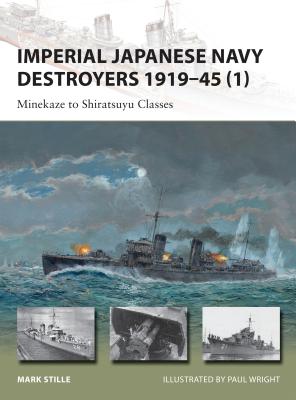Imperial Japanese Navy Destroyers 1919-45 (1): Minekaze to Shiratsuyu Classes

Imperial Japanese Navy Destroyers 1919-45 (1): Minekaze to Shiratsuyu Classes
During the Pacific War, arguably the most successful component of the Imperial Japanese Fleet was its destroyer force. These ships were generally larger than their Allied counterparts and were better armed in most cases. Armed with a large, long-range torpedo (eventually called Long Lance by the Allies), these ships proved themselves as formidable opponents. In the first part of the war, Japanese destroyers were instrumental in an unbroken string of Japanese victories. However, it was not until the Guadalcanal campaign that these ships fully demonstrated their power. In a series of night actions, these ships devastated Allied task forces with a number of daring night attacks using their deadly torpedoes.
This volume will detail the history, weapons and tactics of the Japanese destroyers built before the war. This includes the famous Fubuki class (called Special Type by the Japanese, which were, when completed in the late 1920's, the most powerful class of destroyers in the world. This design forced all other major navies to follow suite and provided the basic design for the next many classes of Imperial Navy destroyers. This book will also cover the three classes built before the Special Type which were based on a German World War I design as well as two classes built after the advent of the Special Type. All of these ships had a rich history as they fought from the first battles of the Pacific War up until the very end when several accompanied the superbattleship Yamato on her death sortie. The final part of the book will be an analysis of the destroyer designs covered in the book which will include an examination of their strengths and weaknesses. The success (or lack of success) of these designs will be discussed and they will be compared to comparable Allied destroyer designs.PRP: 101.32 Lei
Acesta este Prețul Recomandat de Producător. Prețul de vânzare al produsului este afișat mai jos.
81.06Lei
81.06Lei
101.32 LeiLivrare in 2-4 saptamani
Descrierea produsului
During the Pacific War, arguably the most successful component of the Imperial Japanese Fleet was its destroyer force. These ships were generally larger than their Allied counterparts and were better armed in most cases. Armed with a large, long-range torpedo (eventually called Long Lance by the Allies), these ships proved themselves as formidable opponents. In the first part of the war, Japanese destroyers were instrumental in an unbroken string of Japanese victories. However, it was not until the Guadalcanal campaign that these ships fully demonstrated their power. In a series of night actions, these ships devastated Allied task forces with a number of daring night attacks using their deadly torpedoes.
This volume will detail the history, weapons and tactics of the Japanese destroyers built before the war. This includes the famous Fubuki class (called Special Type by the Japanese, which were, when completed in the late 1920's, the most powerful class of destroyers in the world. This design forced all other major navies to follow suite and provided the basic design for the next many classes of Imperial Navy destroyers. This book will also cover the three classes built before the Special Type which were based on a German World War I design as well as two classes built after the advent of the Special Type. All of these ships had a rich history as they fought from the first battles of the Pacific War up until the very end when several accompanied the superbattleship Yamato on her death sortie. The final part of the book will be an analysis of the destroyer designs covered in the book which will include an examination of their strengths and weaknesses. The success (or lack of success) of these designs will be discussed and they will be compared to comparable Allied destroyer designs.Detaliile produsului









